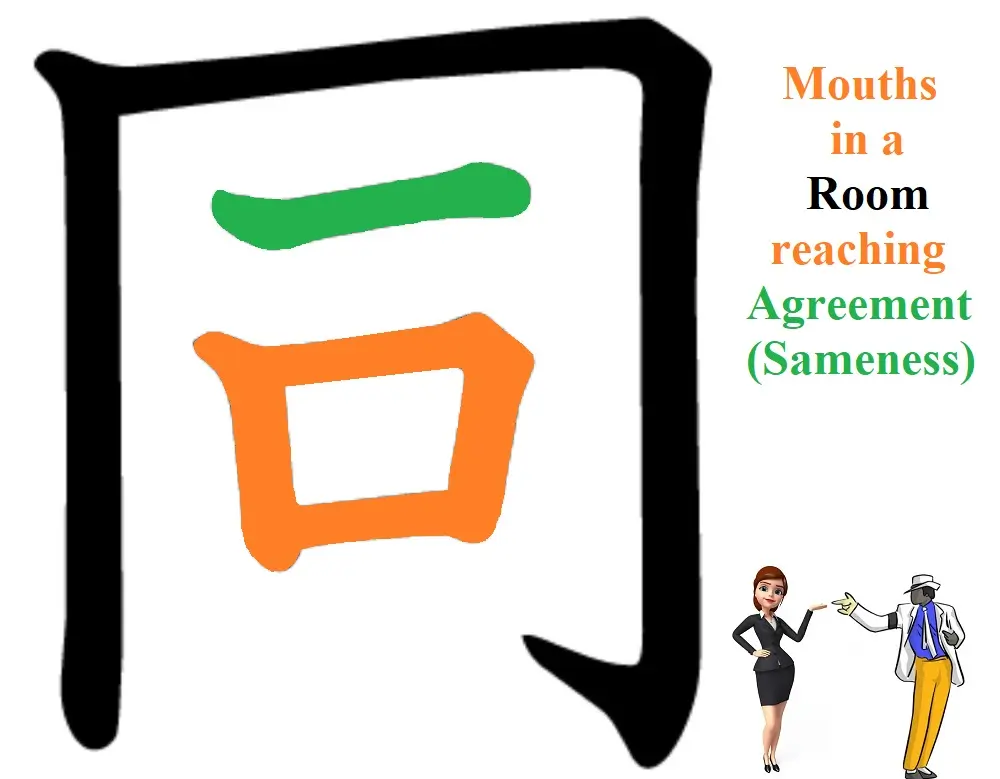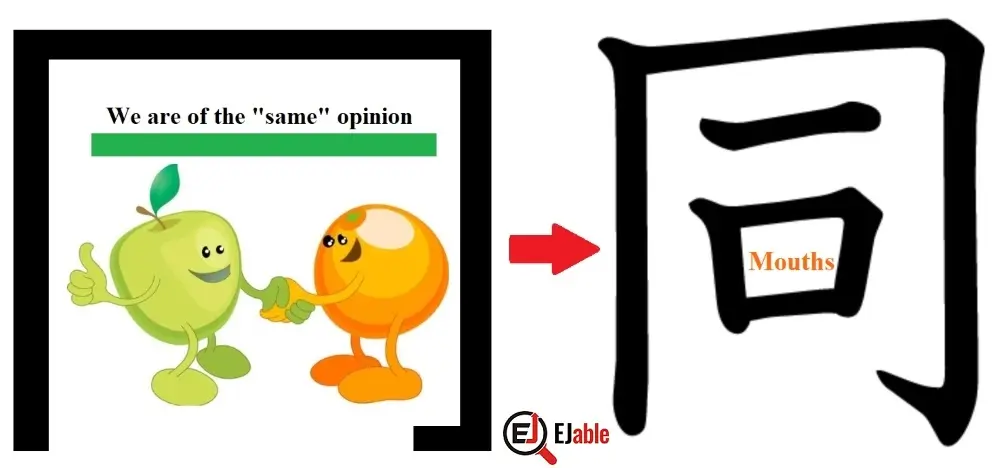Kanji for “Same” or “Identical”: 同 (Ona-ji)

The Japanese kanji for “same” is 同.
- The onyomi (Chinese reading) of 同 is do (ドウ).
- The kunyomi (Japanese reading) of 同 is ona-ji (おな-じ).
The Kanji 同 is constructed with 6 strokes. It is a part of JLPT N4 (please check the JLPT N4 kanji list) and is taught in grade 2 in Japanese schools.
Origin of 同 (Kanji for Same)
The origin of the kanji 同 is not clear. However, let’s see how to remember and connect this Kanji for sameness easily.
Mnemonic: How to Remember the Kanji 同 for “Same” or “Identical”
If you notice, the Kanji 同 is made out of three components (radicals) as follows:
- 冂
- 一
- 口
The first radical The radical 冂 is often referred to as “けいがまえ” (keigamae) in Japanese, and it typically represents the concept of something broad or wide. Visually, it resembles an arch or a wide, open container. This radical is commonly seen at the top or enclosing other elements in a kanji character.
The second component is a horizontal line, and the third is the radical of the Kanji of mouth.
You can use the following picture as the Mnemonic to remember the kanji of “Same.” Please note that though the origin is not clear, the following Mnemonic clearly displays the logic behind the Kanji 同:

Explanation
Consider the outer component of this Kanji as a room with a group of people represented by the radical of mouth. Over that radical, the horizontal line represents the same level or an “agreement”.
This logic behind the kanji 同 portrays the concept of several mouths within an enclosure, implying a gathering of voices or opinions., thus the concept of “sameness”.
A good way to conceptualize 同 is to think of it as representing unity or agreement in opinions as if multiple people (symbolized by the multiple mouths) are speaking the same thing within a shared space (the enclosure). This imagery aligns with the meaning of 同 as “same” or “together.”
Note About 冂
The origin of the radical 冂 can be traced back to ancient Chinese script, where it was used as a pictographic element. Originally, 冂 depicted a broad or open space, like an open area under a roof or an enclosure. This is why it often carries the connotation of something wide or encompassing.
As a component in Chinese characters (hanzi) and subsequently in Japanese kanji, 冂 evolved into a more abstract and stylized form. It’s used mainly as a radical, providing a structural framework for the character rather than contributing a specific meaning or pronunciation.
In terms of its relationship to other kanji characters, 冂 doesn’t directly derive from another character. Instead, it’s one of the many basic graphical components used to construct various characters. For example:
- In the kanji 市 (market, city), 冂 represents the idea of a covering or an enclosure, suggesting a gathering place.
- In 帯 (belt), it again provides a sense of wrapping around.
These uses of 冂 showcase its role as a visual and conceptual component in kanji rather than a character with its own standalone meaning.
Use in Language: Compounded Words with 同
Several compounded words in Japanese use the kanji 同 (どう, dō), which means “same” or “together.” There are 372 Japanese words that begin with the Kanji 同, and it appears in 643 words. Here are some examples:
- 同意 (どうい, dōi): Agreement, consent.
- 同時 (どうじ, dōji): Simultaneously, at the same time.
- 同僚 (どうりょう, dōryō): Colleague, coworker.
- 同感 (どうかん, dōkan): Same feeling, sympathy, agreement.
- 同様 (どうよう, dōyō): Identical, same, similar.
- 同居 (どうきょ, dōkyo): Cohabitation, living together.
- 同類 (どうるい, dōrui): The same kind, alike.
- 同心 (どうしん, dōshin): Consensus, common consent.
- 同封 (どうふう, dōfū): Enclose, include in the same envelope or package.
- 同等 (どうとう, dōtō): Equality, the same level or rank.
- 同盟 (どうめい, dōmei): Alliance, league, union.
- 同胞 (どうほう, dōhō): Fellow countryman, compatriot, brethren.
- 同行 (どうこう, dōkō): Accompanying, going together.
- 同士 (どうし, dōshi): Comrade, fellow.
- 同化 (どうか, dōka): Assimilation, integration.
These examples showcase how the concept of “same” or “together” is incorporated into various contexts, from time and feeling to relationships and actions.
Japanese Words with 同 as a Component
The Kanji 同, meaning “same” or “identical,” is not used as a radical but appears as a component in 28 Japanese Kanji characters. Out of these 28, the following 5 are Jōyō Kanji:
- 筒 (トウ / Tō, つつ / Tsutsu): cylinder, tube
- 銅 (ドウ / Dō): copper
- 興 (コウ / Kō, キョウ / kyō): entertainment, interest, おこる (Okoru) to flourish, おこす ((Okoru) to establish
- 洞 (ドウ / Dō, ほら / Hora): cave
- 胴 (ドウ / Dō): torso, trunk
Conclusion: The Multifaceted 同
In conclusion, the kanji 同 for “Same” is a testament to the richness and depth of the Japanese language.
Emerging from its pictographic origins representing agreement and sameness, 同 has evolved into a symbol that captures the essence of unity, harmony, and shared experience. Its use across various contexts – from everyday language to personal names and idiomatic expressions – illustrates the fundamental human desire for connection and understanding.
Moreover, 同’s incorporation into compound words reveals the intricacies of Japanese thought, where concepts of time, emotion, and action are often seen through a lens of collectivity and consensus. As a character, 同 offers more than a mere linguistic function; it provides a window into the Japanese cultural values of harmony and collective spirit deeply ingrained in Japanese society.
Check other Kanji characters on the page “How to Remember Kanji“. You may also like to read about the common Kanji radicals.

A long-term ex-pat in Japan, Himanshu comes with an IT background in SAP consulting, IT Business Development, and then running the country operations of an IT consulting multinational. Himanshu is the co-founder and Managing Director of ReachExt K.K. and EJable.com. He is also an Advisory Board Member of a Silicon Valley AI/IoT startup.
